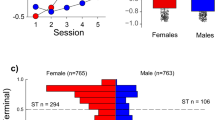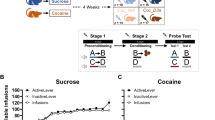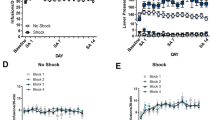Abstract
Individual differences in locomotor responses to novelty and psychostimulants, and sensitization following repeated drug exposure, predict increased sensitivity to the reinforcing effects of psychostimulants and are thought to underlie vulnerability to drug addiction. This study tested whether these factors determine another core feature of drug addiction, the propensity for drug-seeking behavior during abstinence in rats with prior cocaine-self-administration experience. Low and high response groups for each of these factors were determined in outbred rats by the median locomotor response to novelty and amphetamine prior to cocaine self-administration (pre-test), and to amphetamine during abstinence (post-test). Cocaine-seeking behavior during abstinence was measured by the level of drug-paired lever responding during extinction, and also during reinstatement induced by cocaine-associated cues, an amphetamine priming injection, and footshock stress. Animals with low and high locomotor responses to novelty and the amphetamine pre-test showed similar levels of cocaine-seeking behavior during extinction and reinstatement testing. Locomotor responses to amphetamine following cocaine self-administration (post-test) also failed to determine amphetamine's ability to reinstate cocaine-seeking behavior. Conversely, high levels of amphetamine-induced reinstatement were associated specifically with escalating cocaine intake during prior self-administration. These animals also developed locomotor sensitization to amphetamine following cocaine self-administration (post-test vs. pre-test), but the capacity to develop locomotor sensitization was not sufficient to determine a propensity for cocaine-seeking behavior. The findings suggest that the relationship between locomotor responses to novelty, amphetamine and behavioral sensitization a,nd the propensity for cocaine-seeking behavior during abstinence is complex, while the level of drug intake during prior self-administration is a primary determinant of this behavior.
Similar content being viewed by others
Log in or create a free account to read this content
Gain free access to this article, as well as selected content from this journal and more on nature.com
or
References
Ahmed SH, Koob GF . (1997): Cocaine- but not food-seeking behavior is reinstated by stress after prolonged extinction. Psychopharmacology 132: 289–295
Ahmed SH, Koob GF . (1998): Transition from moderate to excessive drug intake: change in hedonic set point. Science 282: 298–300
Bardo MT, Donohew RL, Harrington NG . (1996): Psychobiology of novelty seeking and drug-seeking behavior. Behav Brain Res 77: 23–43
Browman KE, Badiani A, Robinson TE . (1998): The influence of environment on the induction of sensitization to the psychomotor activating effects of intravenous cocaine in rats is dose-dependent. Psychopharmacology 137: 90–98
Childress AR, Mozley PD, McElgin W, Fitzgerald J, Reivich M, O'Brien CP . (1999): Limbic activation during cue-induced cocaine craving. Am J Psychiatry 156: 11–18
De Vries TJ, Schoffelmeer ANM, Binnekade R, Mulder AH, Vanderschuren LJMJ . (1998): Drug-induced reinstatement of heroin- and cocaine-seeking behaviour following long-term extinction is associated with expression of behavioural sensitization. Eur J Neurosci 10: 3565–3571
De Vries TJ, Schoffelmeer ANM, Binnekade R, Vanderschuren LJMJ . (1999): Dopaminergic mechanisms mediating the incentive to seek cocaine and heroin following long-term withdrawal of IV drug self-administration. Psychopharmacology 143: 254–260
De Wit H, Stewart J . (1981): Reinstatement of cocaine-reinforced responding in the rat. Psychopharmacology 75: 134–143
De Wit H, Wise RA . (1977): Blockade of cocaine reinforcement in rats with the dopamine receptor blocker pimozide, but not with noradrenergic blockers phentolamine and phenoxybenzamine. Can J Psychol 31: 195–203
DSM-IV: Diagnostic and Statistical Manual of Mental Disorders, 4th Ed. Washington, DC, American Psychiatric Association
Erb S, Shaham Y, Stewart J . (1996): Stress reinstates cocaine-seeking behavior after prolonged extinction and a drug-free period. Psychopharmacology 128: 408–412
Erb S, Shaham Y, Stewart J . (1998): The role of corticotropin-releasing factor and corticosterone in stress- and cocaine-induced relapse to cocaine seeking in rats. J Neurosci 18: 5529–5536
Fuchs RA, Tran-Nguyen LTL, Specio SE, Groff RS, Neisewander JL . (1998): Predictive validity of the extinction/reinstatement model of drug craving. Psychopharmacology 135: 151–160
Gerber GJ, Stretch R . (1975): Drug-induced reinstatement of extinguished self-administration behavior. Pharmacol Biochem Behav 3: 1061–1066
Gong W, Neill DB, Justice JB Jr . (1996): Locomotor response to novelty does not predict cocaine place preference conditioning in rats. Pharmacol Biochem Behav 53: 191–196
Grant S, London ED, Newlin DB, Villemagne VL, Liu X, Contoreggi C, Phillips RL, Kimes AS, Margolin A . (1996): Activation of memory circuits during cue-elicited cocaine craving. Proc Natl Acad Sci USA 93: 12040–12045
Heidbreder CA, Thompson AC, Shippenberg TS . (1996): Role of extracellular dopamine in the initiation and long-term expression of behavioral sensitization to cocaine. J Pharmacol Exp Ther 278: 490–502
Henry DJ, White FJ . (1991): Repeated cocaine administration causes persistent enhancement of D1 dopamine receptor sensitivity within the rat nucleus accumbens. J Pharmacol Exp Ther 258: 882–890
Henry DJ, White FJ . (1995): The persistence of behavioral sensitization to cocaine parallels enhanced inhibition of nucleus accumbens neurons. J Neurosci 15: 6287–6299
Horger BA, Giles MK, Schenk S . (1992): Pre-exposure to amphetamine and nicotine predisposes rats to self-administer a low dose of cocaine. Psychopharmacology 107: 271–276
Horger BA, Shelton K, Schenk S . (1990): Pre-exposure sensitizes rats to the rewarding effects of cocaine. Pharmacol Biochem Behav 37: 707–711
Jaffe JH, Cascella NG, Kumor KM, Sherer MA . (1989): Cocaine-induced cocaine craving. Psychopharmacology 97: 59–64
Meil WM, See RE . (1997): Lesions of the basolateral amygdala abolish the ability of drug associated cues to reinstate responding during withdrawal from self-administered cocaine. Behav Brain Res 87: 139–148
Mendrek A, Blaha CD, Phillips AG . (1998): Pre-exposure of rats to amphetamine sensitizes self-administration of this drug under a progressive ratio schedule. Psychopharmacology 135: 416–422
Piazza PV, Deminière JM, Le Moal M, Simon H . (1989): Factors that predict individual vulnerability to amphetamine self-administration. Science 245: 1511–1513
Piazza PV, Deminière JM, Le Moal M, Simon H . (1990): Stress- and pharmacologically-induced behavioural sensitization increases vulnerability to acquisition of amphetamine self-administration. Brain Res 514: 22–26
Piazza PV, Le Moal M . (1996): Pathophysiological basis of vulnerability to drug abuse: role of an interaction between stress, glucocorticoids, and dopaminergic neurons. Ann Rev Pharmacol Toxicol 36: 359–378
Pierre PJ, Vezina P . (1997): Predisposition to self-administer amphetamine: the contribution of response to novelty and prior exposure to the drug. Psychopharmacology 129: 277–284
Robbins SJ, Ehrman RN, Childress AR, O'Brien CP . (1997): Relationships among physiological and self-report responses produced by cocaine-related cues. Addictive Behaviors 22: 157–167
Robinson TE, Berridge KC . (1993): The neural basis of drug craving: an incentive-sensitization theory of addiction. Brain Res Rev 18: 247–291
Self DW . (1998): Neural substrates of drug craving and relapse in drug addiction. Annals of Medicine 30: 379–389
Self DW, Barnhart WJ, Lehman DA, Nestler EJ . (1996): Opposite modulation of cocaine-seeking behavior by D1- and D2-like dopamine receptor agonists. Science 271: 1586–1589
Self DW, Genova LM, Hope BT, Barnhart WJ, Spencer JJ, Nestler EJ . (1998): Involvement of cAMP-dependent protein kinase in the nucleus accumbens in cocaine self-administration and relapse of cocaine-seeking behavior. J Neurosci 18: 1848–1859
Self DW, Nestler EJ . (1998): Relapse to drug seeking: neural and molecular mechanisms. Drug Alcohol Depend 51: 49–60
Shaham Y, Stewart J . (1996): Effects of opioid and dopamine receptor antagonists on relapse induced by stress and re-exposure to heroin in rats. Psychopharmacology 125: 385–391
Sinha R, Catapano D, O'Malley S . (1999): Stress induced craving and stress response in cocaine dependent individuals. Psychopharmacology 142: 343–351
Steketee JD . (1998): Injection of SCH 23390 into the ventral tegmental area blocks the development of neurochemical but not behavioral sensitization to cocaine. Behav Pharmacol 9: 69–76
Tran-Nguyen LT, Fuchs RA, Coffey GP, Baker DA, O'Dell LE, Neisewander JL . (1998): Time-dependent changes in cocaine-seeking behavior and extracellular dopamine levels in the amygdala during cocaine withdrawal. Neuropsychopharmacol 19: 48–59
Vanderschuren LJMJ, Schoffelmeer ANM, Mulder AH, De Vries TJ . (1999): Dopaminergic mechanisms mediating the long-term expression of locomotor sensitization following pre-exposure to morphine and amphetamine. Psychopharmacology 143: 244–253
Vezina P . (1996): D1 dopamine receptor activation is necessary for the induction of sensitization by amphetamine in the ventral tegmental area. J Neurosci 16: 2411–2420
Wise RA, Murray A, Bozarth MA . (1990): Bromocriptine self-administration and bromocriptine-reinstatement of cocaine-trained and heroin-trained lever pressing in rats. Psychopharmacology 100: 355–360
Acknowledgements
We wish to acknowledge Michela Marinelli and Cindy Brandon for helpful comments and discussion pertaining to this study. This work was supported by United States Public Health Service Grants DA 10460 and DA 08227, and by the Abraham Ribicoff Research Facilities of the Connecticut Mental Health Center.
Author information
Authors and Affiliations
Corresponding author
Rights and permissions
About this article
Cite this article
Sutton, M., Karanian, D. & Self, D. Factors That Determine a Propensity for Cocaine-Seeking Behavior during Abstinence in Rats. Neuropsychopharmacol 22, 626–641 (2000). https://doi.org/10.1016/S0893-133X(99)00160-8
Received:
Revised:
Accepted:
Issue date:
DOI: https://doi.org/10.1016/S0893-133X(99)00160-8
Keywords
This article is cited by
-
Role of mesolimbic cannabinoid receptor 1 in stress-driven increases in cocaine self-administration in male rats
Neuropsychopharmacology (2023)
-
Novelty-induced locomotor behavior predicts heroin addiction vulnerability in male, but not female, rats
Psychopharmacology (2022)
-
Investigating individual differences in opioid-taking and opioid-seeking behavior in male rats
Psychopharmacology (2022)
-
Inhibition of a cortico-thalamic circuit attenuates cue-induced reinstatement of drug-seeking behavior in “relapse prone” male rats
Psychopharmacology (2022)
-
Escalation and reinstatement of fentanyl self-administration in male and female rats
Psychopharmacology (2021)



